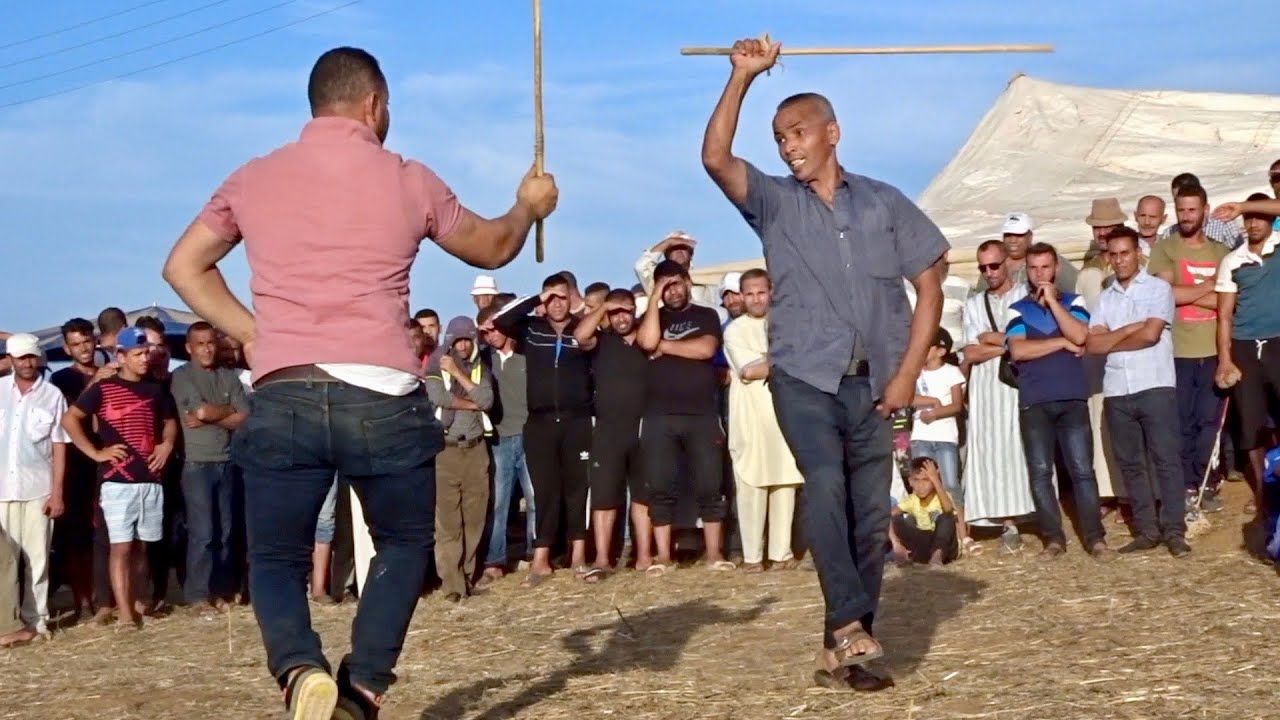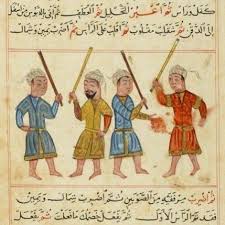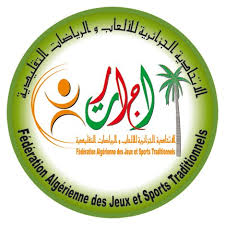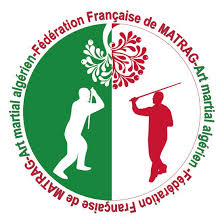
El Matrag (Algeria)
- Name of sport (game): El Matrag
- Name in native language: El Matrag
- Place of practice (continent, state, nation):
Algeria
- History:
It is difficult to accurately trace the history of this sport, but it is certain that its cradle is the Oran province, that is, the northwest region of Algeria, and it appeared more than two centuries ago. According to some sources, the shepherds of this region have defended themselves in this way against herds thieves. However, it seems that this sport originally has roots in war because the moves are very similar to saber techniques. Even if we can only speculate, with the lack of tangible sources on this topic, we can imagine that the Berber Arabs have practiced the fight for sticks from ancient times because there are several reasons in the history of these people with long series of constant conflicts with different intensity. Therefore, the values and traditions of warriors were at the center of men's lives which logically resulted in continuous training of the warriors and rivalry preparing for real fights. In addition, it seemed more logical to use olive tree sticks to train sabers fight that were easily available. A different situation was with sabers that had to be kept. Moreover, the length and weight of these sticks were similar to sabers, we know, for example, that the Berber warriors of Kabila have been using Flyssa since the 18th century, which is a sword that can be long up to one meter. Studies show that one of Berberian large sabers can reach up to 1m 15cm, i.e. the size of Matragas. In addition, Berbers from the times of Emir Abdelkader used a slightly curved long sword of Turkish origin, less than one meter long called "yatagan" in battle.

The unreliable information about the origin of Matrag reaches back to the genesis of its practice, as we know it today, exactly in the time of Emir Abdelkader, that is, at a time when a large proportion of Algerians are armed with resistance against the French invasion that began in 1830. It seems obvious that this state of intense and almost continuant war which lasted over fifteen years (from 1830–1847), favoured and developed even more belligerent practices in the Arab-Berber tribes of the Algerian West, which as it should be remembered, was the main area of the Muslim struggle against the French occupier. Therefore, it is probably no accident that the Matrag art has been particularly developed in this region to this day. Moreover, there is a direct relationship between the Matrag and Kader's resistance to the French. The style of this struggle was finally shaped and codified. However, it contains a strong symbolic element because to this day the Matrag in some way embodies the spirit of fight and insubordination of Algerians against the enemy and injustice.
It is worth to remember that the great masters ("sheikhs") of Matrag often refer to a verse from the Koran that refers to this practice, this gives Matrag the deep Arab-Muslim identity of this martial art: "He (Moses) says:" This is my stick on which I withstand, which I use to tear off (trees) for my sheep and use it for other purposes” (Koran 20/18). This is a fragment of the Koran in which Moses is in the holy valley of Tuva, where Allah addressed him directly, saying: "And what is in your right hand, Moses?" He says: "This is my stick on which I withstand, which I tear off (trees) for my sheep and use it for other purposes." [Allah] said to him, "Drop it, Moses." He dropped it and there was a slithering snake. [Allah] says: "Grab him and do not be afraid of anything: we will restore him to his first state" (Koran 20 / 17-21). So the Matrag masters see in the sentence "[...} and I use it for other purposes" that there is a reference to stick fighting. Perhaps this is why some say without evidence that a practicing Matrag can become a champion only after facing the snake with a cane, as part of a kind of initiation and secret ritual
This practice was passed and practiced discreetly during the colonial period. The French authorities were reluctant to look at this martial art that connected the "natives" with the deeply rooted culture that the occupier wanted to wipe. Spirit of a fight among them but mainly prepared them specifically for armed combat. It would seem that the Matrag was not so clearly visible during the days of the first leaders of independent Algeria. In the early 1980s, this art came out of some sort of oblivion, since it was actually practiced far away from human clusters, especially in forests. It should be noted that some old Matrag masters still have a concern to pass on their knowledge in a discreet manner to their "guendouz" (the student chosen to receive the entire master's knowledge) or their students in general. Nevertheless, in Algeria, there are many Matrag clubs with their headquarters in cities.
- Description:
The word "Matrag" is a term in the Algerian dialect from the classical Arabic "mitraq", which means "hammer" and which in French gave it the sound "matraque". The Matrag defines both the Algerian martial art and the weapon used to practice it which art is also often referred to the "Algerian Cane". Indeed this is a kind of simple cane made from a wild olive tree or oleaster which in Algeria is called "zeboudj". Is a tree comes from North Africa, where it grows in its natural state but also occurs in other countries around the Mediterranean Sea, grows in forests, maquis or in valleys. The quality of this wood is unique, it combines two basic features of weapons: flexibility and solidity. Those who practice this art know how difficult it is to break a stick made of this tree. In addition, the Zebudj stick is relatively heavy and thickset, probably due to the high concentration of juice.
It should be noted in this connection that those who prepare battle sticks cut them at a certain time of the year when their juice concentration is optimal. The size of the Matrag is about two cubits, i.e. about 1m15; when it comes to thickness, it is variable, a thin cane allows faster handling, while a thicker cane is certainly heavier but even more dangerous. Let’s say that the average diameter varies between 1 and 2 cm. Flexibility, density and solidity make Matrag a very effective weapon, comparing it with a saber is not an exaggeration, besides practicing this sport, people who know the damage that can be caused by this stick often make such a comparison.
The hits are strictly codified and there are fourteen, all the "edge" of the stick, pushing hits which are much more dangerous are formally prohibited, except in situations of self-defence, for example before a person armed with a knife. So we have two strokes (inside / outside) in the ears (a tarch, literally "stun"), two in the chin (lihya, "chin" in Arabic), two in the forehead (ra`s), two in the ribs (janb) , two in the lower part of leg (rijl), two in the arms (katf) and two in the elbows (mirfaq). These fourteen strokes, combinations were made up of several strokes given in a strictly defined order which combinations are known and practiced by everyone. So, for example, all Matrag practitioners start a fight after they greet each other respectfully by tapping the cane at their opponent, making an initial and obligatory combination called "wajbat", which consists of four moves, one for each ear, one for a chin and one on the forehead.
The course of competition is quite simple, the attacker makes a series of strokes, the defender deflects them in accordance with established techniques and then, in turn, performs the same series to the opponent. The goal is to combine short hisâbs, which can lead to the continuous repetition of a series of fifteen or twenty movements. This training requires a lot of work and concentration because players must repeat this type of series. The goal after learning the gestures, combinations and sequences of hits is to get used to unpredictable strokes. In this way, at a higher level practitioners do competitions, they use many variants or introduce unforeseen hits into their scheme to hit the opponent, who deflects the hits Sometimes the opponents must be very fast and strong, he must show great efficiency to counteract these unexpected hits. These strokes are usually exchanged in continuous forward and backward movement as well as circular movements.
Duels between masters or experienced practitioners naturally resemble fights in Asian styles such as Arnis (Philippines), Kung Fu (China) or Aikijo which is a Japanese martial art whose weapon is a stick with a length of 1m20 and the techniques are very similar to Matrag. It should also be noted that the current great Matrag masters are often experts in Asian martial arts (judo, aikido, karate Shotokan etc. Matrag practitioners are mutually respectful, humble and honest people. Brotherhood and honor are their cardinal value.
There are 4 elementary moves used in the matrag:
The tarcha dakhlaniya which consists of the interior strike;
The tarcha barrania which consists of the external strike;
The lahiya which consists of the lower strike;
The flush which consists of the upper strike. - Current status:
The Matrag is practiced in public during Wadas, which are large solemn meetings in the open air, something similar to a market. There you can hear bards proclaiming ancient Bedouin poems, eat couscous sitting cross-legged under tents but above all the old tradition of la'b al-bârûd, which has at least two centuries of existence is consolidated. It's about the rivalry of riders, during which they drive at high speed perform acrobatic exercises loading and unloading the rifle as well as shooting at full gallop and simultaneously by the "team". This rivalry and Matrag are therefore associated as two essential aspects of warrior culture and Algerian practice which confirms the ancient martial origin of the stick martial art.
- Importance (for practitioners, communities etc.):
For Algerians, it seems that Matrag is a real living treasure of their cultural heritage that deserves to be developed and disseminated. This art that has positive values is worth rediscovering, practicing and passing on to future generations because it is part of a wonderful civilization and the intangible cultural heritage of Algeria.
- Contacts:
Fédération Algeriènne Des Jeux et Sports traditionnels
Rue 05 juillet bargua Bechar, 08002 Béchar
Tel: 0021349215917
Fb: https://www.facebook.com/F%C3%A9d%C3%A9ration-Algeri%C3%A8nne-Des-Jeux-et-Sports-traditionnels-168128913541039/
Federation Française Matrag
Tel: 0609694679
Fb: https://www.facebook.com/ffdmatrag/
- Sources of information :
Video:
https://www.youtube.com/watch?v=SqFmjFJVfcA
https://www.youtube.com/watch?v=KFjmhGt9Tks
https://www.youtube.com/watch?v=X21Nj-oaNl4
https://www.youtube.com/watch?v=thWeuHXRJzcSource of photos in this article:
https://pl.pinterest.com/pin/596304806901888933/; https://nessahra.net/el-matrag-la-maabza-la-fantasiadecouvrez-les-anciens-sports-de-combat-encore-pratiques-en-algerie/; https://fr.shafaqna.com/le-matrag-un-art-martial-musulman/; - Gallery:

